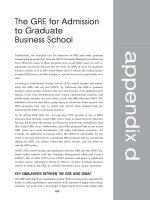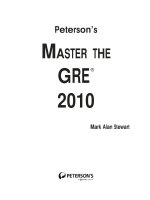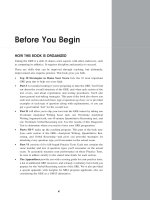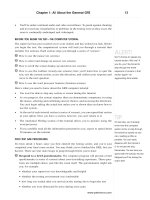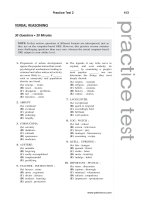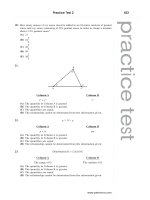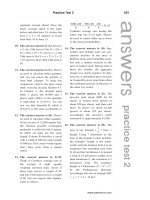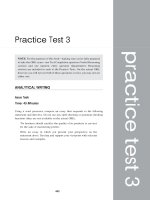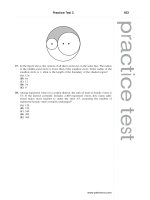Tài liệu Master the Gre 2010 - Part 65 pptx
Bạn đang xem bản rút gọn của tài liệu. Xem và tải ngay bản đầy đủ của tài liệu tại đây (74.76 KB, 8 trang )
The GRE for Admission
to Graduate
Business School
Traditionally, the standard test for admission to MBA and other graduate
management programs has been the GMAT (Graduate Management Admission
Test). However, many of these programs now accept GRE scores as well, so
applicants can choose between the two tests. In 2008, at least 134 graduate
business schools (116 in the United States and 18 outside the United States)
accepted GRE scores, and this number is expected to increase significantly over
time.
According to Educational Testing Service (ETS), which designs and admin-
isters the GRE (but not the GMAT), by embracing the GRE a graduate
business school greatly enhances the size and diversity of its applicant pool.
Indeed, it has been demonstrated that women, international students, and
double-major students are more likely to take the GRE than the GMAT. The
additional diversity that these groups bring to classrooms helps explain why
MBA programs that seek to enrich and enliven their student body are
embracing the GRE in increasing numbers.
At its official GRE Web site (www.gre.org), ETS provides a list of MBA
programs that officially accept GRE scores. Keep in mind, however, that this
list may not be up-to-the-minute and that some schools may not publicize that
they accept GRE scores. Additionally, some MBA programs that do not accept
GRE scores as a rule nevertheless will make individual exceptions—for
example, for applicants in regions where the GMAT is unavailable. In any
event, if you seek admission to a particular MBA program and are considering
taking the GRE, you should contact the school directly and ask about its
current GRE policy.
NOTE: ETS used to design and administer both the GRE and the GMAT, the
latter under contract with the Graduate Management Admission Council
(GMAC). But in 2004, ETS lost its GMAT contract, and hence a significant
revenue source. Subsequent efforts by ETS to convince graduate business
schools to embrace the GRE as a GMAT alternative have clearly succeeded.
KEY SIMILARITIES BETWEEN THE GRE AND GMAT
The GRE and GMAT are remarkably similar. Both are designed to measure the
kinds of verbal, quantitative, and analytic skills expected of upper-class college
students. Yet aside from a knowledge of high school–level math (which both
appendixd
....................................................................................
623
tests assume), neither the GRE nor the GMAT attempt to test any specific knowledge
area. This means that you don’t need any coursework in finance or accounting to
perform well on the GMAT, nor do you need to take an archaeology or English literature
class to score high on the GRE.
Testing procedures and mechanics are virtually the same for both tests. The GRE and
GMAT are both administered by computer and are computer-adaptive, meaning that
they conform to your individual ability level on the fly. For both tests, a paper-based
version is offered in regions where the computerized testing system is unavailable.
Neither test is inherently more difficult than the other. The methodology for evalu-
ating and scoring the essays (the Analytical Writing section) is essentially the same
for both, and research by ETS shows that scaled Quantitative Ability and Verbal
Ability scores for the GRE convert reliably to scaled GMAT scores. In fact, at the
official GRE Web site (www.gre.org), ETS provides a GRE-to-GMAT score conversion
chart.
KEY DIFFERENCES BETWEEN THE GRE AND GMAT
Despite their similarities, certain differences between the GRE and the GMAT should
not be ignored, especially by applicants who must choose between the two tests. To begin
with, the registration fee is lower for the GRE than for the GMAT (the difference,
currently $110, is subject to change). Also, the GRE is offered in more cities and
countries than the GMAT. As for the tests themselves, although they are quite similar
overall, each test contains some unique question types that distinguish it from the other,
as the following table suggests.
APPENDIXES624
.................................................................
..............................................................................................
www.petersons.com
GRE Format
Analytical Writing (75 min.)
• Issue Perspective (1 essay,
45 min.)
• Argument Analysis (1 essay,
30 min.)
Quantitative Reasoning (45 min.)
• Problem Solving (14 questions)
• Quantitative Comparison
(14 questions)
Verbal Reasoning (30 min.)
• Reading Comprehension
(8 questions)
• Analogies (9 questions)
• Antonyms (7 questions)
• Sentence and Text Completion
(6 questions)
Unscored Section (30–45 min.)
• Either Quantitative Reasoning
or Verbal Reasoning
GMAT Format
Analytical Writing (60 min.)
• Issue Analysis (1 essay, 30 min.)
• Argument Analysis (1 essay, 30 min.)
Quantitative Ability (75 min.)
• Problem Solving (22–23 questions)
• Data Sufficiency (14–15 questions)
Verbal Ability (75 min.)
• Reading Comprehension
(12–13 questions)
• Sentence Correction (14–15
questions)
• Critical Reasoning (14–15
questions)
The most significant difference between the two tests lies in how they measure verbal
abilities. Although the Reading Comprehension format is essentially the same on both
exams, this is where the close resemblance ends. The GRE places far more emphasis on
vocabulary, both out-of-context (Analogies and Antonyms) and in-context (Sentence
Completion), while the GMAT focuses much more on critical reasoning and on identify-
ing and correcting problems in grammar, sentence structure, and idiom (Sentence
Correction).
Differences in how the two tests gauge quantitative abilities are less significant. Both
tests cover the same substantive ground (high school–level arithmetic, number theory,
algebra, and geometry) in about the same proportions; both tests include questions
involving interpretation of graphical data (tables, line charts, bar graphs, and so on);
and both tests employ the traditional Problem Solving format for at least one half of
the questions. The main distinction involves the second format. The GRE Quanti-
tative Comparison format is quite different from the GMAT Data Sufficiency format.
Nevertheless, both are designed to emphasize math concepts and quantitative rea-
soning as opposed to problem solving, and neither format is inherently more difficult
than the other. They’re just different.
Appendix D: The GRE for Admission to Graduate Business School 625
.................................................................
..............................................................................................
www.petersons.com
As for their Analytical Writing components, the Argument Analysis task is essentially
the same for both the GRE and the GMAT. However, the GRE Issue Analysis task
differs from its GMAT counterpart in three respects:
• The GRE imposes a 45-minute time limit, compared with the GMAT’s more strict
30-minute limit.
• GRE test takers choose between two Issue topics; GMAT test takers are not offered
a choice.
• The range of Issue topics in the GRE pool (from which two topics are randomly
selected and presented to each test taker) is much broader than that of the GMAT
pool. GRE Issues embrace the entire spectrum of topics that are of general academic
interest to college and university students; the topics in the GMAT pool focus more
on business issues (especially management, leadership, organizational skills, and
ethics).
WHICH TEST (GRE OR GMAT) SHOULD YOU TAKE?
Of course, the answer to this question is not the same for each and every aspiring
graduate business student. As the preceding discussion suggests, whether you should
take the GRE or the GMAT depends on your own answers to the following questions:
• Do my top-choice business schools accept GRE scores?
• Is the registration fee an issue?
• Are both tests available where I live or attend school?
• Am I interested exclusively in business education, or do I have alternative or
additional academic aspirations?
• Am I likely to perform better on one test than the other, given what I know about
their differences?
If you’re still not sure which test you should take after answering these questions,
consider taking them both—assuming, of course, that you can adequately prepare for
both and can afford both registration fees.
APPENDIXES626
.................................................................
..............................................................................................
NOTE
The folks at ETS who design the
GRE have been considering
incorporating Critical
Reasoning questions into the
test and eliminating Analogies
and Antonyms. So sometime in
the future, the GRE might look
even more like the GMAT.
www.petersons.com
ABOUT THE AUTHOR
Mark Alan Stewart (B.A., Economics; J.D., University of California at Los Angeles) is an
attorney and a preeminent authority and top-selling author on the subject of graduate-level
entrance exams. For more than a decade, Mr. Stewart served as consultant to schools in the
University of California and California State University systems in graduate-level entrance
exam programs. His books on LSAT, GRE, and GMAT preparation are perennial top sellers be
top sellers among aspiring law, business, and graduate students. His other book-length
publications for graduate-level admission include the following (all published by Peterson’s):
Master the GMAT; GRE-LSAT Logic Workbook; GRE Answers to the Real Essay Questions;
GRE-LSAT-GMAT-MCAT Reading Comprehension Workbook; Words for Smart Test Takers;
Math for Smart Test Takers; and Perfect Personal Statements—Law, Business, Medical,
Graduate School.
